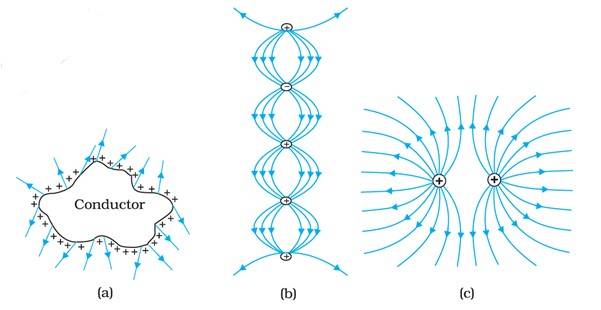Physics Ncert Solutions Class 12th
Get insights from 1.2k questions on Physics Ncert Solutions Class 12th, answered by students, alumni, and experts. You may also ask and answer any question you like about Physics Ncert Solutions Class 12th
Follow Ask QuestionQuestions
Discussions
Active Users
Followers
New answer posted
5 months agoContributor-Level 10
8.1 Radius of the each circular plate, r = 12 cm = 0.12
Distance between the plates, d = 5 cm = 0.05 m
Charging current, I = 0.15 A
Permittivity of free space, = 8.85
Capacitance between two plates is given by the relation,
C = , where A = Area of each plate = =
C = = 8.007
F
Charge on each plate, q = CV, where V = potential difference across plates
Differentiating both sides w.r.t. t, we get
= C
But = I, therefore
= = 1.87 V/s
1.87 V/s
The displacement current across the plates is the same as the conduction current. Hence the displacement current is 0.15 A
Kirchhoff's first rule is
New answer posted
5 months agoContributor-Level 10
1.27 Dipole moment of the system, p = q = Cm
Rate of increase of electric field per unit length, = N
Force experienced by the system is given by the relation, F = qE = q
= (q =p = = N
The force is N in the negative z-direction i.e. opposite to the direction of electric field. Hence, the angle between electric field and dipole moment is 180
.
Torque ( ) is given by the relation, = pE = 0
Therefore, the torque experienced by the system is zero.
New answer posted
5 months agoContributor-Level 10
Ans.1.26
(a) The field lines showed in (a) do not represent electrostatic field lines because field lines must be normal to the surface of the conductor.
(b) The field lines shown in (b) do not represent electrostatic field lines because field lines can not emerge from a negative charge and cannot terminate at a positive charge.
(c) The field lines shown in (c) represent electrostatic field line. This is because the field lines emerge from the positive charge and repel each other.
(d) The field lines shown in (d) do not represent electrostatic field lines because the field lines should not intersect each other.
New answer posted
5 months agoContributor-Level 10
1.25 Excess electrons on an oil drop, n = 12
Electric field intensity, E = 2.55
Density of oil, 1.26 g / = 1.26 g/
Acceleration due to gravity, g = 9.81 m/
Charge of an electron, e = 1.60C
Let the radius of the oil drop be r
Force (F) due to electric field (E) is equal to the weight of the oil drop (W)
F = W
Eq = mg
Ene =
= =
r = 9.815 m = 9.815 mm
New answer posted
5 months agoContributor-Level 10
1.24 The given conditions are explained in the adjacent diagram

Where A and B represent two large, thin metal plates, parallel and close to each other. The outer surface of A is shown as I, outer surface of B is shown as II and the surface in between A and B is shown as III.
Charge density of plate A, = 17.0 C/
Charge density of plate B, = 17.0
C/
(a) & (b) In the region, I and III, electric field E is zero, because charge is not enclosed by the respective plates.
(c) Electric field, E in the region II is given by
E =
, where
= Permittivity of free space = 8.854
E = N/C = 1.92 N/C
New answer posted
5 months agoContributor-Level 10
1.23 Electric field produced by the infinite line charge at a distance d having linear charge density
is given by
E = , where
E = Electric field = 9 N/C
= Permittivity of free space = 8.854
d = 2 cm = 0.02 m
Hence, = 9
8.854
0.02 = 10
New answer posted
5 months agoContributor-Level 10
1.22
(a) Diameter of the sphere, d = 2.4 m, Radius, r = 1.2 m
Surface charge density, = 80 μC/
Total charge on the surface of the sphere is given by Q =
Hence Q = 80
(b) The total electric flux (
where
Q = 1.447
New answer posted
5 months agoContributor-Level 10
1.21 Electric field intensity, E, at a distance d, from the centre of a sphere containing net charge q is given by the relation,
E =
Where
q= Net charge
E = 1.5
d = 2r = 20 cm = 0.2 m
q = E
= 6.67 nC
The net charge on the sphere is 6.67 nC
New answer posted
5 months agoContributor-Level 10
10.21 Consider that a single slit of width
Therefore width of each slit,
Angle of diffraction is given by the relation,
Now, each of these infinitesimally small slit sends zero intensity in the direction of Ø.
Hence, the combination of these slits will give zero intensity.
New answer posted
5 months agoContributor-Level 10
1.20 Electric flux,
Radius of Gaussian surface, r = 10 cm = 0.1 m
(a) Electric flux piercing through a surface depends on the net charge enclosed inside a body, not on the size of the body. Hence, if the radius is doubled, the net flux passing does not change. The net flux passing will remain as -1 N
(b) The relation between point charge and the electric flux is given by
Where
Hence point charge q = φ
= - 8.854
Taking an Exam? Selecting a College?
Get authentic answers from experts, students and alumni that you won't find anywhere else
Sign Up on ShikshaOn Shiksha, get access to
- 65k Colleges
- 1.2k Exams
- 682k Reviews
- 1800k Answers


